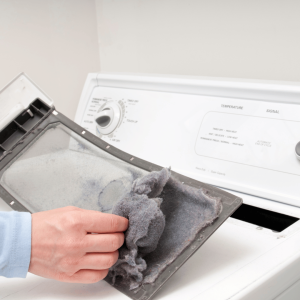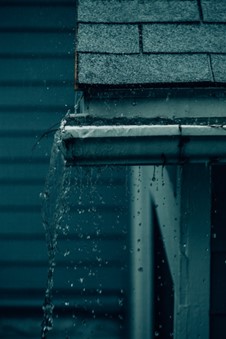
Understanding Dryer Traps: Maintenance, Necessity, and More
Maintaining your dryer is crucial for ensuring its efficiency and safety. One often overlooked component in dryer maintenance is the dryer trap, also known as the lint trap. This small yet vital part plays a significant role in preventing lint build-up and ensuring that your dryer operates smoothly.
In this article, we’ll explore what a dryer vent trap is, how to clean it properly, and why it’s essential for your home’s safety. We’ll also answer common questions about dryer traps and vents, helping you understand their differences and the importance of regular maintenance. By the end of this guide, you’ll have a clearer understanding of how to keep your dryer in optimal condition and avoid potential hazards.
Whether you’re handling interior home maintenance tasks or focusing on preventative home maintenance, understanding and maintaining your dryer trap is a key part of keeping your home safe and efficient. Let’s dive into the details of what a dryer vent trap is and why it matters.
What is a Dryer Vent Trap?
A dryer vent trap, commonly known as the lint trap, is an essential component of your dryer’s ventilation system. It plays a crucial role in capturing lint and debris that are shed from your clothes during the drying process. Here’s a closer look at what a dryer vent trap is and how it functions:
Definition and Function
- Definition: A dryer vent trap is a mesh screen or filter located inside the dryer’s door or panel. Its primary purpose is to capture lint and small particles that are released from wet clothes as they tumble and dry.
- Function: As clothes dry, the hot air from the dryer circulates through the drum and out through the vent. The dryer trap catches the lint before it can enter the venting system, helping to prevent blockages and maintain efficient airflow.
Importance of the Dryer Trap
- Preventing Lint Build-Up: By trapping lint, the dryer vent trap prevents it from accumulating in the dryer’s venting system, which can lead to reduced efficiency and potential fire hazards.
- Improving Dryer Efficiency: A clean dryer trap ensures that air flows freely through the dryer, allowing it to operate more efficiently and reducing drying times.
- Safety: Regular maintenance of the dryer trap is crucial for home safety. Lint build-up can become a fire hazard if not properly managed.
How It Fits Into Home Maintenance
In the context of interior home maintenance, keeping the dryer vent trap clean is a vital task. It’s part of a broader preventative home maintenance routine that includes regular checks and cleaning to ensure that your home appliances operate safely and efficiently.
Understanding the role of the dryer vent trap helps in appreciating why it’s necessary to maintain it properly. Regular cleaning and inspection of the trap are essential steps in avoiding more significant issues and ensuring the longevity of your dryer.
How Do You Clean a Dryer Trap?
Proper maintenance of your dryer includes regular cleaning of the dryer trap to ensure optimal performance and safety. Here’s a step-by-step guide on how to clean a dryer trap effectively:
Step-by-Step Guide
- Turn Off the Dryer
- Safety First: Before you begin cleaning, make sure the dryer is turned off and completely cool to avoid any risk of burns or electrical hazards.
- Remove the Trap
- Access the Trap: Locate the lint trap, which is usually found inside the dryer door or on the top of the dryer. Gently pull the trap out of its slot.
- Clean the Trap
- Remove Lint: Use a vacuum cleaner with a hose attachment or a lint brush to remove the accumulated lint from the trap. Ensure you clean both sides of the trap to remove all debris.
- Wash if Necessary
- For Stubborn Residue: If there is any stubborn residue or sticky build-up, wash the trap with warm, soapy water. Use a soft brush or cloth to scrub it gently.
- Rinse and Dry: Rinse the trap thoroughly and let it dry completely before reinserting it into the dryer.
- Reinsert the Trap
- Proper Placement: Once the trap is dry, slide it back into its slot in the dryer. Ensure it fits snugly and securely in place.
Tips for Effective Cleaning
- Regular Maintenance: Clean the dryer trap after every load of laundry to prevent lint build-up. This simple task helps maintain dryer efficiency and reduces fire risk.
- Check the Venting System: While cleaning the trap, it’s also a good idea to check the venting system for any lint accumulation. Use a vent cleaning brush or call a professional if needed.
- Preventative Measures: Consider scheduling regular dryer vent cleaning as part of your preventative home maintenance routine. This helps ensure that both the trap and the entire venting system remain free of obstructions.
By following these steps, you can keep your dryer running efficiently and safely. Regular maintenance of the dryer trap is a crucial aspect of interior home maintenance and helps in avoiding more significant issues down the line.
Are Dryer Lint Traps Necessary?
Dryer lint traps are more than just a small component of your dryer—they play a crucial role in ensuring the appliance’s efficiency and safety. Here’s why they are necessary:
Importance of Dryer Lint Traps
Preventing Fire Hazards
- Lint Accumulation: Lint is highly flammable and can easily ignite if it accumulates and comes into contact with the dryer’s heating elements. A properly functioning lint trap captures most of the lint before it enters the venting system, reducing the risk of a fire.
Improving Dryer Efficiency
- Efficient Operation: When the lint trap is clean, air can flow freely through the dryer. This allows clothes to dry more quickly and evenly, improving the efficiency of the drying process. A clogged trap can cause the dryer to work harder, leading to longer drying times and increased energy consumption.
Extending the Life of Your Dryer
- Reduced Wear and Tear: By capturing lint, the trap helps prevent blockages in the dryer’s venting system. This reduces strain on the dryer’s motor and heating elements, helping to extend the appliance’s lifespan.
Benefits of Regular Maintenance
- Enhanced Safety: Regularly cleaning the lint trap helps in maintaining safety by reducing the risk of fire. It’s a critical part of preventative home maintenance that ensures your home stays safe.
- Cost Savings: A well-maintained dryer operates more efficiently, which can lead to lower energy bills. Additionally, preventing lint build-up reduces the likelihood of costly repairs or replacements.
- Convenience: Regularly cleaning the lint trap ensures that your dryer continues to perform optimally, avoiding unexpected breakdowns and the inconvenience of having to wait for repairs.
Integration into Home Maintenance
In the broader context of interior home maintenance, keeping your dryer lint trap clean is a fundamental task. It fits into a comprehensive preventative home maintenance strategy that includes regular checks and cleaning of various home systems and appliances.
In summary, dryer lint traps are essential for maintaining dryer efficiency, safety, and longevity. Incorporating regular cleaning of the lint trap into your home maintenance routine is a simple yet effective way to ensure your dryer operates smoothly and safely.
Do Dryers Have a Second Lint Trap?
Many people are unaware that some dryers come equipped with a secondary lint trap. Understanding whether your dryer has one and how to maintain it is essential for comprehensive dryer care. Here’s what you need to know:
Understanding Secondary Lint Traps
Location of the Secondary Lint Trap
- Typical Placement: While not all dryers have a secondary lint trap, those that do often place it in the dryer’s venting system or near the exhaust. It may be located behind a panel or within the vent duct.
- Check Your Model: Refer to your dryer’s user manual to determine if your model has a secondary lint trap and where it is located.
Purpose of the Secondary Lint Trap
- Additional Filtration: A secondary lint trap provides extra filtration to catch lint that may bypass the primary lint trap. This additional layer of protection helps prevent lint build-up in the venting system.
- Enhanced Efficiency: By capturing more lint, the secondary trap helps maintain optimal air flow, which can improve drying efficiency and reduce the risk of blockages.
How to Check and Clean a Secondary Lint Trap
Consult the Manual
- Locate the Trap: Follow the instructions in your dryer’s manual to find and access the secondary lint trap.
Remove and Clean
- Access the Trap: Carefully remove the secondary lint trap according to the manufacturer’s guidelines.
- Clean Thoroughly: Use a vacuum or a soft brush to remove lint and debris. If necessary, wash the trap with warm, soapy water, and let it dry completely before reinserting it.
Regular Maintenance
- Routine Checks: Include checking and cleaning the secondary lint trap as part of your regular dryer maintenance routine. This helps ensure that both traps are functioning effectively and that your dryer remains in top condition.
Importance in Home Maintenance
Maintaining both primary and secondary lint traps is a crucial part of preventative home maintenance. It fits into the broader category of interior home maintenance by ensuring that your dryer operates efficiently and safely. Regular maintenance of all parts of your dryer, including the secondary lint trap, helps prevent potential issues and extends the appliance’s lifespan.
What is the Difference Between a Vent and a Trap?
Understanding the difference between a dryer vent and a dryer trap is crucial for maintaining your dryer’s efficiency and safety. Here’s a breakdown of these two components and how they work together:
Dryer Vent
Definition and Function
- Definition: The dryer vent is a duct or pipe that channels hot, moist air from the dryer to the outside of your home. It is an essential part of the dryer’s exhaust system.
- Function: Its primary role is to carry the warm, humid air generated during the drying process out of the house, preventing moisture build-up inside and reducing the risk of mold and mildew.
Maintenance
- Regular Cleaning: The vent should be cleaned regularly to prevent lint build-up, which can obstruct airflow and increase the risk of fire. Use a vent cleaning brush or hire a professional for thorough cleaning.
- Inspection: Check the vent periodically for any signs of damage or blockages. Ensure that it is securely connected and free of leaks.
Dryer Trap (Lint Trap)
Definition and Function
- Definition: The dryer trap, or lint trap, is a filter located inside the dryer that captures lint and small particles shed from clothes during the drying cycle.
- Function: Its main purpose is to prevent lint from entering the dryer’s venting system, which helps in maintaining efficient airflow and reducing the risk of fires.
Maintenance
- Cleaning: Clean the lint trap after every load of laundry to ensure it is free of debris. A clean trap helps maintain dryer efficiency and safety.
- Inspection: Regularly inspect the trap for any signs of wear or damage, and replace it if necessary.
How They Work Together
- Complementary Roles: The lint trap and the vent work together to ensure your dryer operates safely and efficiently. The lint trap captures the lint before it reaches the vent, while the vent carries the expelled air outside.
- System Efficiency: Proper maintenance of both the trap and the vent is crucial for preventing lint build-up, which can lead to inefficient drying and increased fire risk.
Integration into Home Maintenance
Incorporating regular checks and cleaning of both the dryer vent and the trap into your interior home maintenance routine is vital. This fits within the broader scope of preventative home maintenance, ensuring that your dryer operates efficiently and safely.
What Happens if You Block a Dryer Vent?
Blocking a dryer vent can have serious implications for both the efficiency of your dryer and the safety of your home. Here’s what you need to know about the consequences of a blocked dryer vent:
Consequences of a Blocked Dryer Vent
Reduced Dryer Efficiency
- Extended Drying Times: When the vent is blocked, hot, moist air cannot escape properly. This results in longer drying times for your clothes, which can increase your energy bills and put extra strain on your dryer.
- Increased Energy Consumption: The dryer has to work harder to dry your clothes, leading to higher energy usage and cost.
Increased Fire Risk
- Lint Build-Up: Blockages in the venting system can lead to lint accumulation, which is highly flammable. If lint comes into contact with the dryer’s heating elements, it can ignite and cause a fire.
- Potential Hazards: According to the U.S. Fire Administration, failure to clean the dryer vent is one of the leading causes of dryer fires.
Moisture and Mold Issues
- Moisture Build-Up: A blocked vent traps moist air inside the dryer and the surrounding area. This can lead to mold and mildew growth in your laundry room or home.
- Damage to Surroundings: Persistent moisture can damage walls, ceilings, and floors, leading to costly repairs.
Decreased Dryer Longevity
- Wear and Tear: The added strain on the dryer caused by a blocked vent can lead to premature wear and tear on the appliance’s components, potentially leading to expensive repairs or replacements.
Prevention and Maintenance
Regular Cleaning
- Schedule Maintenance: Include dryer vent cleaning as part of your preventative home maintenance routine. Regularly clean the vent and check for any blockages to ensure proper airflow.
- Professional Inspection: Consider hiring a professional for thorough vent cleaning and inspection, especially if you notice any signs of blockage or inefficiency.
Routine Checks
- Inspect the Venting System: Periodically check the vent for signs of damage or obstruction. Ensure it is properly connected and not kinked or crushed.
- Monitor Dryer Performance: Pay attention to any changes in dryer performance, such as extended drying times or unusual noises, which may indicate a blocked vent.
Integration into Home Maintenance
Managing a blocked dryer vent is an essential part of interior home maintenance. By incorporating regular checks and maintenance into your broader preventative home maintenance strategy, you can avoid the issues associated with blocked vents and keep your dryer running efficiently and safely.
Maintaining a clean and functional dryer vent trap is crucial for the safety and efficiency of your dryer. Understanding the roles of the dryer vent and trap, as well as the potential consequences of neglecting them, helps you keep your home safe and your appliances running smoothly. Regular cleaning and maintenance are essential components of effective interior home maintenance and preventative home maintenance.
Key Takeaways
- Dryer Trap Importance: The dryer trap, or lint trap, captures lint and debris, preventing it from entering the dryer’s venting system. Regular cleaning is vital to ensure it functions effectively.
- Difference Between Vent and Trap: While the dryer vent expels hot, moist air outside, the lint trap catches lint and particles within the dryer. Both play crucial roles in maintaining dryer efficiency and safety.
- Impact of Blockages: A blocked dryer vent can lead to reduced efficiency, increased fire risk, moisture problems, and decreased dryer longevity.
Take Action
To ensure your dryer remains in top condition, integrate these maintenance practices into your home care routine:
- Clean the Dryer Trap: After every load, remove lint and debris from the trap to maintain optimal performance.
- Inspect and Clean the Dryer Vent: Regularly check and clean the vent to prevent blockages and reduce fire hazards. Consider professional cleaning if necessary.
- Schedule Regular Maintenance: Incorporate dryer vent cleaning and inspection into your preventative home maintenance routine to avoid issues and ensure safety.
For comprehensive home care and maintenance, trust HomeSmiles. Our extensive 18-point interior and exterior home maintenance services cover everything from gutter cleaning to dryer vent cleaning and more. Let us help you keep your home in perfect condition and avoid costly repairs down the line.
Contact HomeSmiles today to schedule your preventative maintenance service and ensure your home remains safe and efficient.
- Protecting Your Property: Why the Right Cleaning Method Makes All the Difference
- The #1 Thing That’s Dulling Your Curb Appeal (And How to Fix It)
- How Maintenance Bundles Provide Peace of Mind for Busy Small Business Owners and Facility Managers
- Essential vs. Complete Home Packages: Choosing the Right Preventive Care for Your Property
- How a Simplified Service Model Benefits Both Homeowners and Franchisees Alike


